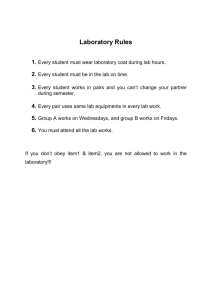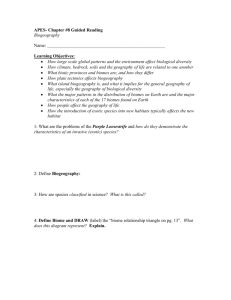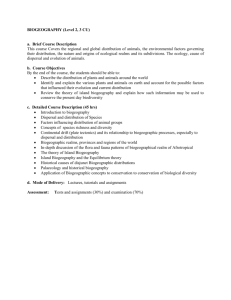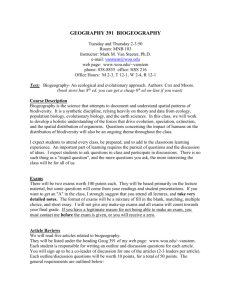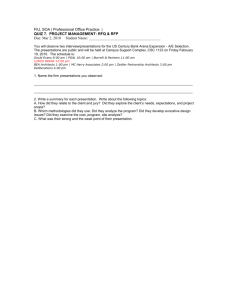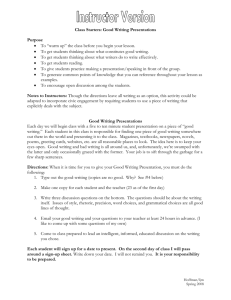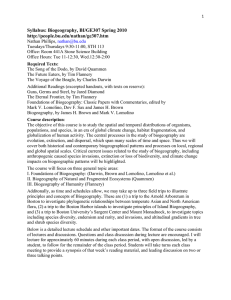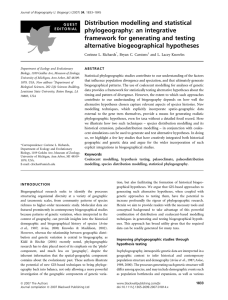Sillabus
advertisement
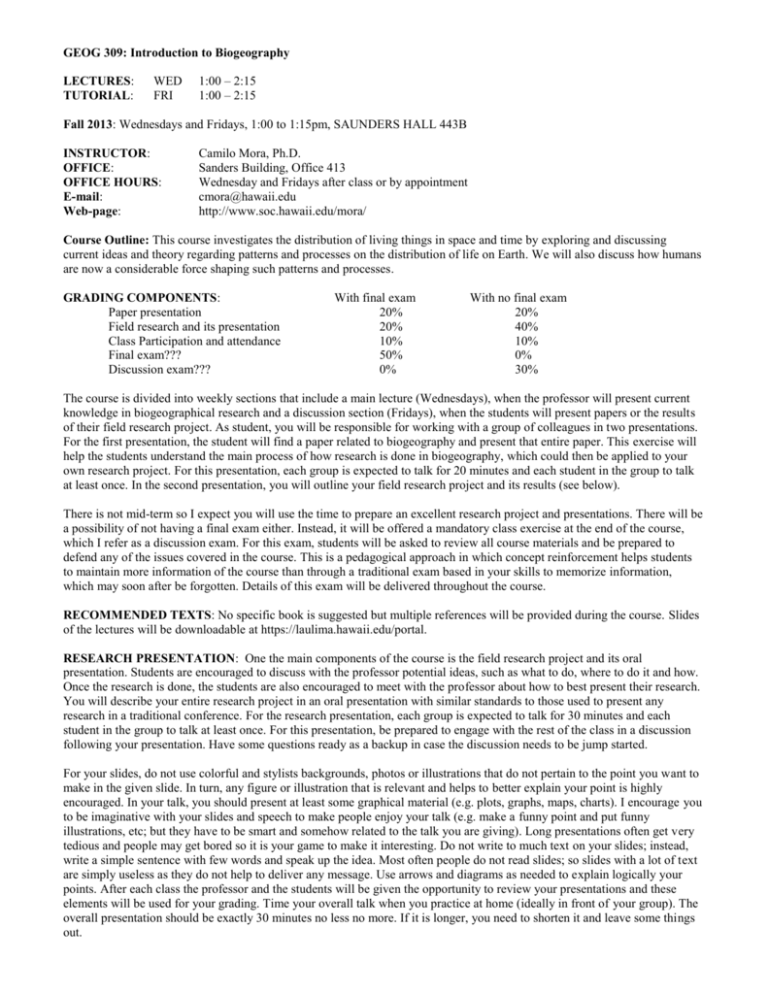
GEOG 309: Introduction to Biogeography LECTURES: TUTORIAL: WED FRI 1:00 – 2:15 1:00 – 2:15 Fall 2013: Wednesdays and Fridays, 1:00 to 1:15pm, SAUNDERS HALL 443B INSTRUCTOR: OFFICE: OFFICE HOURS: E-mail: Web-page: Camilo Mora, Ph.D. Sanders Building, Office 413 Wednesday and Fridays after class or by appointment cmora@hawaii.edu http://www.soc.hawaii.edu/mora/ Course Outline: This course investigates the distribution of living things in space and time by exploring and discussing current ideas and theory regarding patterns and processes on the distribution of life on Earth. We will also discuss how humans are now a considerable force shaping such patterns and processes. GRADING COMPONENTS: Paper presentation Field research and its presentation Class Participation and attendance Final exam??? Discussion exam??? With final exam 20% 20% 10% 50% 0% With no final exam 20% 40% 10% 0% 30% The course is divided into weekly sections that include a main lecture (Wednesdays), when the professor will present current knowledge in biogeographical research and a discussion section (Fridays), when the students will present papers or the results of their field research project. As student, you will be responsible for working with a group of colleagues in two presentations. For the first presentation, the student will find a paper related to biogeography and present that entire paper. This exercise will help the students understand the main process of how research is done in biogeography, which could then be applied to your own research project. For this presentation, each group is expected to talk for 20 minutes and each student in the group to talk at least once. In the second presentation, you will outline your field research project and its results (see below). There is not mid-term so I expect you will use the time to prepare an excellent research project and presentations. There will be a possibility of not having a final exam either. Instead, it will be offered a mandatory class exercise at the end of the course, which I refer as a discussion exam. For this exam, students will be asked to review all course materials and be prepared to defend any of the issues covered in the course. This is a pedagogical approach in which concept reinforcement helps students to maintain more information of the course than through a traditional exam based in your skills to memorize information, which may soon after be forgotten. Details of this exam will be delivered throughout the course. RECOMMENDED TEXTS: No specific book is suggested but multiple references will be provided during the course. Slides of the lectures will be downloadable at https://laulima.hawaii.edu/portal. RESEARCH PRESENTATION: One the main components of the course is the field research project and its oral presentation. Students are encouraged to discuss with the professor potential ideas, such as what to do, where to do it and how. Once the research is done, the students are also encouraged to meet with the professor about how to best present their research. You will describe your entire research project in an oral presentation with similar standards to those used to present any research in a traditional conference. For the research presentation, each group is expected to talk for 30 minutes and each student in the group to talk at least once. For this presentation, be prepared to engage with the rest of the class in a discussion following your presentation. Have some questions ready as a backup in case the discussion needs to be jump started. For your slides, do not use colorful and stylists backgrounds, photos or illustrations that do not pertain to the point you want to make in the given slide. In turn, any figure or illustration that is relevant and helps to better explain your point is highly encouraged. In your talk, you should present at least some graphical material (e.g. plots, graphs, maps, charts). I encourage you to be imaginative with your slides and speech to make people enjoy your talk (e.g. make a funny point and put funny illustrations, etc; but they have to be smart and somehow related to the talk you are giving). Long presentations often get very tedious and people may get bored so it is your game to make it interesting. Do not write to much text on your slides; instead, write a simple sentence with few words and speak up the idea. Most often people do not read slides; so slides with a lot of text are simply useless as they do not help to deliver any message. Use arrows and diagrams as needed to explain logically your points. After each class the professor and the students will be given the opportunity to review your presentations and these elements will be used for your grading. Time your overall talk when you practice at home (ideally in front of your group). The overall presentation should be exactly 30 minutes no less no more. If it is longer, you need to shorten it and leave some things out. Suggested topics for field work projects include: what is the pattern of the number of species (for specific groups such as birds, insects, plants, fishes, etc) perpendicular to the shore or around the islands and why?. What is the status of coral reefs around Oahu and why?. How different is body size or abundance of fishes inside versus outside protected areas in Oahu? Are beaches with similar physical characteristics but different number of visitors more or less diverse? Lecture Schedule Week 1 August 28: Introduction August 30: Finding your paper for presentation. Bring your portable computer or tablet. Week 2 September 4: Basic concepts on biogeographical research and definition of field work projects. September 6: You will present the idea of your research project (5 minutes) Week 3 September 11: Continuation of class presentation of your research project. September 13: Paper presentation groups 1 and 2 Week 4 September 18: Examples of biogeographical research September 20: Paper presentation groups 3 and 4 Week 5 September 25: Speciation and extinction September 27: Paper presentation groups 5 and 6 Week 6 October 2: Tree of life October 4: Paper presentation groups 7 and 8 Week 7 October 9: Human evolution October 11: Research presentation group 1 Week 8 October 16: Biogeographical regions October 18: Research presentation group 2 Week 9 October 23: Geographic range October 25: Research presentation group 3 Week 10 October 30: Species richness November 1: Research presentation group 4 Week 11 November 6: Abundance November 8: Research presentation group 5 Week 12 November 13: Body size November 15: Research presentation group 6 Week 13 November 20: Ecosystem functioning November 22: Research presentation group 7 Week 14 November 27: The future of biodiversity November 29: No Class. Week 15 December 4: Research presentation group 8 December 6: Final exam or discussion exam
